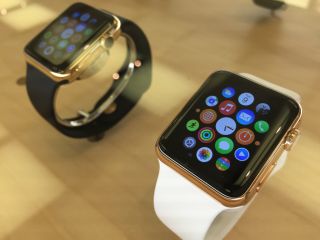

The Apple Watch wants to keep every Dick Tracy alive and healthy. He will be notified when it’s politic to get up and stand, how many steps he takes getting to a perp, and whether fellow cops, friends or criminal masterminds are anywhere in the vicinity. By improving the smartwatch experience, Apple is on to something: the attentional device that might rewrite people’s sense of sensor technology. If actively applied to improve real health—combined physical, mental, social and spiritual well-being—it might help the self-health movement really get moving.
An Attentional Device
Hands are tools. Hands use tools. Humans are toolmaking, tool using animals. We enjoy working with tools—which then become extensions of our hands.
That in a nutshell is the smartwatch advantage. As Farhad Manjoo points out in the New York Times, the Apple Watch easily and quietly notifies him of incoming information through its wristband—so deftly, many don’t notice (not all agree, however). After a while the watch can begin to feel like a whole other sensor, in a way that phones do not.
And with potentially less intrusiveness than delivering information through the eyes (Google Glass) or through the ears. Humans can’t easily turn off auditory information. Profoundly visual, we also have a hard time selecting out “constantly on” information in our visual field (though pilots and increasingly others are taught to do just that.) Watches however, feel like natural tools. Today they require a cellphone in the pocket. With expected technological improvements, that will change. Since hands also provide a large sensory input to the brain, smartwatches can also be used to provide people a different sense of how to use electronic sensors.
A Sensor Device
Sensors like accelerometers and gyromotors allow small computers like cellphones to manage movement and position in three dimensional space. Yet people distrust sensors posed against their own senses. For us, seeing is believing.
Yet our biological sensors are just as fallible—and often more inaccurate—than our electronic versions.
Look at someone’s face in a crowded room. You sense all the facial minutiae that feeds human emotion and understanding, and think you see the whole rest of the room you’re in.
But that’s just a series of illusory, highly useful tricks perpetrated by the brain. At the moment you look at anything your optic nerve is sensing everything upside and backward, in thousands of individual packets, with a big blind spot right in the middle. The rest of the room you see so clearly? A trick of memory, powerfully effective until a magician walks through the door. Another purposeful trick is how the brain takes those thousands of packets and turns them into useful information—the approximate congregate image we call visual reality. It’s an image we thoroughly believe in, until someone demonstrates its flaws.
The Apple Watch and other smartwatches have the ability to train people to the real reality that the brain processes information—and that many other sensors can be added on to the usual ones to help us get through the day. So the type I diabetic can be rapidly informed that she is getting hypoglycemic. In time people with major illnesses will be able to “sense” their blood pressure or clotting capacity.
But their first action should not be to call a doctor. It would be far better to first change behavior—a role for which smartwatches may prove particularly useful.
Self-Health
Much of the early health care money in cellphones and smartwatches will be made monitoring disease states. However, their public health advantages may lie more in modifying behavior.
At present, lifestyle may add 10 or more years of adult life while medical care adds two to three. How many friends and acquaintances people engage with through their daily lives is ultimately a bigger factor in a population's cardiovascular health than all the statins and cardiologists in the world. More friends mean less heart disease. Health—including lifespan and general well-being—is much more affected by how we live and how our work and communities are organized than by medical care, well organized or not. The doubling of lifespans for the world in the last century came about through sanitation, nutrition, vaccination and education—not the comparatively small improvements brought by antibiotics and oncology.
The Apple Watch is already primed to tell people how often they sit versus stand. Sitting is a major factor in cardiovascular health, even for marathon runners. A watch that communicates rapidly may soon be able to take a photograph and tell you how many calories of pure sugar lie inside that next meal. It can set you up to find people to walk with during your lunch break at work, as well as chide you when you go to bed very late, your biological clocks blitzed by the bright light of a favorite television serial.
Self-health through smartwatches could aid the population’s health in a far more forceful way than through medically profitable ones. It might also provide great benefits in matters of pleasure and spirit.
Living and Beauty
One of the knocks on IT is that it separates people from the natural world. It looks like the folks at Apple want to do something about that.
They are trying hard at making the new Apple Watch beautiful (and positioning it as a luxury item). Much of the beauty that it will portray—particularly on its many possible watch faces—is the beauty of the natural world.
An effective attentional sensor device should make it easier and more fruitful for us to acknowledge—and utilize—our natural environment. Inclement weather people are happier out in nature. They open up their senses, bond with each other and the living world around them.
Why does this work? Because the body itself is information—a large series of interlocking information systems, like immunity and the brain, that constantly crosstalk and communicate. Their ceaseless conversation rebuilds your body.
For illness and aging are not the falling apart of the “machine.” They are the failure to rebuild and renew. Most of the body is new in a series of weeks, its information updated on the fly.
By providing attention to specific sensors and information, the Apple Watch can aid self-health. It can also make interacting with the environment more fun, as it paves the way for further wearable embedded sensors.
In the future many of us may not wish to become cyborgs, and those who do may be surprised at what they lose. Yet people are always using new tools, generally in unpredictable ways. The Apple Watch will not replace medical personnel. But it can make healthy living easier to access and use.
That’s enough benefit right there.



